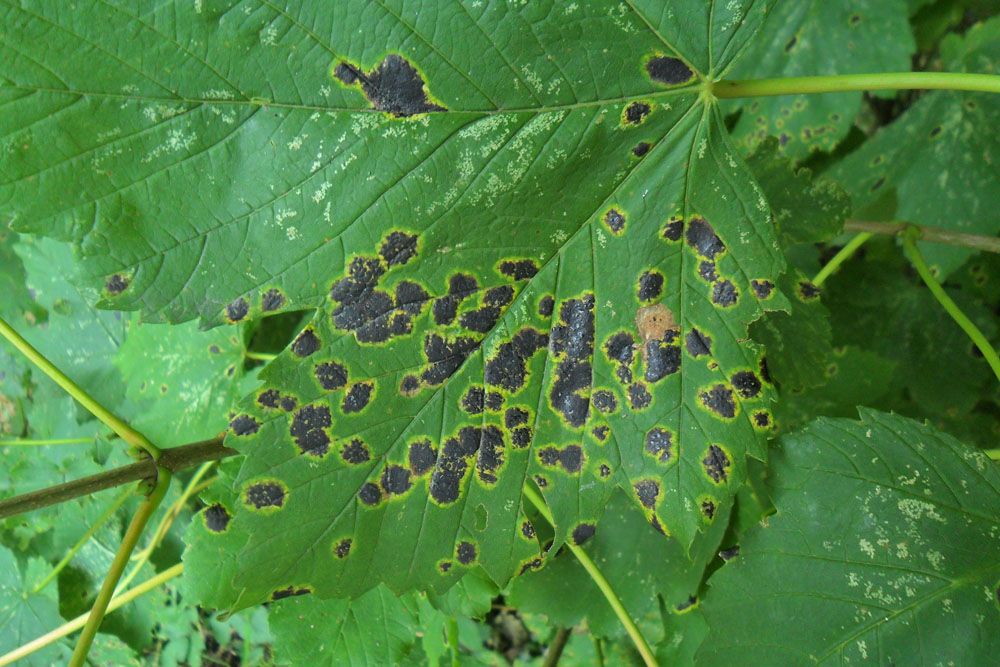
Tar Spot
Tar spot (Rhytisma Acerinum)
Tar spot is a common fungal leaf spot disease that is mostly aesthetic. Many maple species, including (but not limited to) sugar maple, silver maple, and Norway maple, are susceptible to tar spots. Tar spot can also harm boxelder (ash-leaved maple), willow, holly, and tulip trees.
Identification or symptom of tar spot:
Early symptoms of tar spots appear on leaves in early summer. However, they are typically overlooked due to their inconspicuous nature. The leaf dots are light green to yellow-green at this stage. The pathogen species that causes tar spot has a different pattern of development. Tiny black dots are produced by one species, which subsequently combine into more extensive black patches. Another species generates black blotches with a diameter of an inch or more. The third tar spot pathogen causes more minor spots, and this type of tar spot is known as speckled tar spot. Tar spots can cause sure leaves to drop early late in the season. The Tar patch on the host tree generally remains unnoticed until the leaves start to fall.
Life Cycle:
The tar spot fungus (P. maydis) is an obligatory pathogen, which means it can only grow and reproduce in the presence of a live host. In Midwestern states where the illness has been diagnosed, Phyllachora maydis can overwinter. On maize leaves that overwinter in Midwest U.S. fields, ascospore viability can range from 2.5 percent to 25 percent in the spring. The stromata release spores in the presence of rain or high humidity, which are distributed by rain splashes or the wind. In 12-15 days after infection, new stromata grow within infected tissue.
Causes of tar spot?
Some variables influence the prevalence and recurrence of this fungal infection. Some circumstances, such as the weather, are beyond our control. There are, however, certain things you may do to assist avoid infection. Tar spots may be prevented by keeping your garden and yard clean. One of the most excellent techniques for overwintering on fallen leaves is to remove all of your maple’s fallen leaves and bag or compost them to eliminate the nearest source of tar spot spores. If you wait until spring to pick up the fallen leaves, the spores on them will most likely infect new greenery, restarting the cycle.
Control:
Because of its recent emergence, our knowledge of this disease in the United States is limited. Several management techniques may aid in the prevention and reduction of tar spots.
Consider fungicides:
Fungicides have been demonstrated to be effective in treating tar spots, although the timing of fungicide treatments is critical. Some fungicides have been shown to minimize tar spot, and some fungicides with 2ee labeling can be used to treat tar spot. Better fungicide application time guidelines are being developed.
Irrigation planning:
Excessive or frequent light watering might raise the likelihood of tar spot development. Reduced leaf moisture frequency and duration may minimize disease. Irrigation’s impact on tar spot has received little investigation, so farmers should speak with an extension consultant to learn more about how irrigation might affect disease development.
Switch to a different crop:
Crop rotation appears to provide just a minimal influence in tar spot prevention. On the other hand, this method will enable leftovers to degrade and, therefore, minimize the primary inoculum. It is still unknown how many years of rotation away from corn will be required to reduce inoculum.
Residue maintenance:
Tillage appears to serve just a modest influence in tar spot prevention. Tilling fields may help lower the quantity of overwintering tar spot inoculum in a lot by burying contaminated waste and increasing the pace of decomposition. Still, it will not lessen the risk of infection from the locally disseminated inoculum.
